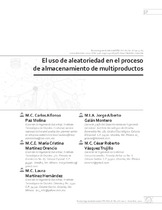Mostrar el registro sencillo del ítem
El uso de aleatoriedad en el proceso de almacenamiento de multiproductos
| dc.contributor.author | Paz Molina, Carlos Alfonso | |
| dc.contributor.author | Martínez Orencio, María Cristina | |
| dc.contributor.author | Martínez Hernández, Laura | |
| dc.contributor.author | Galán Montero, Jorge Alberto | |
| dc.contributor.author | Vásquez Trujillo, César Roberto | |
| dc.coverage.spatial | Seccional Medellín | spa |
| dc.date.accessioned | 2020-11-26T13:25:45Z | |
| dc.date.available | 2020-11-26T13:25:45Z | |
| dc.date.issued | 2018 | |
| dc.identifier.uri | http://hdl.handle.net/20.500.11912/6599 | |
| dc.description | p. 57 - 63 | spa |
| dc.description.abstract | Presentamos el siguiente trabajo realizado en un almacén multiproductos de un proveedor de la industria automotriz con el objetivo de aplicar una herramienta que establezca las reglas de distribución y colocación de estos productos. Los resultados indican una reducción de los tiempos muertos por horas/semana en dos de los procesos iniciales de esta empresa. Las políticas de asignación de almacenaje y ubicación proponen un sistema de uso óptimo de los espacios en dicha área, para evitar implicaciones que competen al manejo y al flujo de materiales. El sistema propuesto puede ser aplicado en almacenes con área reducida de almacenaje y diferentes marcas, características de producción, especificaciones físicas, para los cuales establecer almacenes con administración tradicional de asignación sin holgura conduce a pérdidas de material, piezas sin registro, uso de áreas de almacenaje con material no correspondiente, errores de inventario, etc. | spa |
| dc.description.abstract | We are presenting the following article done into a multi-products warehouse of an automotive parts supplier in order to apply a tool toward to follow the rules of distribution and location of these products. The results indicate the reduction of idle time per hours/weeks in both of the initial process of the plant. The assign politics of storage and location propose an optimal usage system of the spaces belong to this area, to avoid implications that will interfere with the management and flow of materials. The system proposed could be used in warehouses with reducing areas of storage and different production brands and settings, physical specifications for which the establishment of warehouses with traditional administration of allocation without slack leads to loss of material, pieces without registration, use of storage areas with non-corresponding material, inventory errors, etc. | spa |
| dc.format.mimetype | application/pdf | |
| dc.language.iso | spa | |
| dc.publisher | Universidad Pontificia Bolivariana | spa |
| dc.relation.ispartof | Revista Ingeniería Industrial | spa |
| dc.rights | Attribution-NonCommercial-NoDerivatives 4.0 International | * |
| dc.rights.uri | http://creativecommons.org/licenses/by-nc-nd/4.0/ | * |
| dc.subject | Aleatoriedad | spa |
| dc.subject | Almacén | spa |
| dc.subject | Multiproductos | spa |
| dc.subject | Random | spa |
| dc.subject | Warehouse | spa |
| dc.subject | Multi-products | spa |
| dc.title | El uso de aleatoriedad en el proceso de almacenamiento de multiproductos | spa |
| dc.type | article | spa |
| dc.rights.accessRights | openAccess | spa |
| dc.type.hasVersion | publishedVersion | spa |
| dc.description.sectional | Medellín | spa |
| dc.identifier.instname | instname:Universidad Pontificia Bolivariana | spa |
| dc.identifier.reponame | reponame:Repositorio Institucional de la Universidad Pontificia Bolivariana | spa |
| dc.identifier.repourl | repourl:https://repository.unab.edu.co/ |


